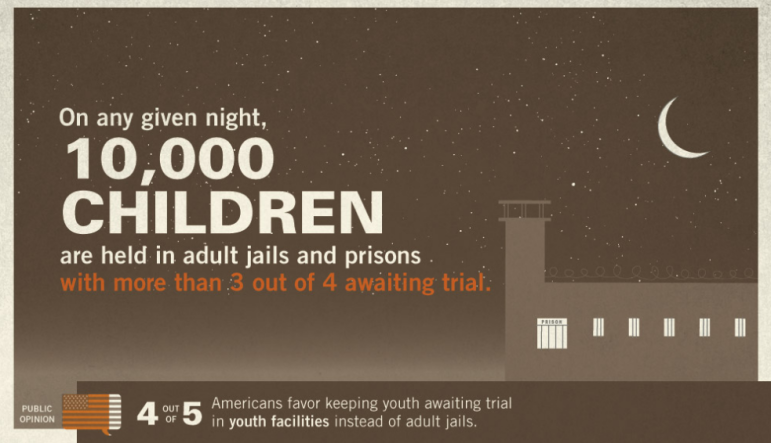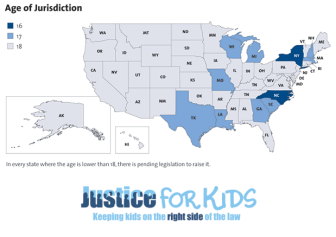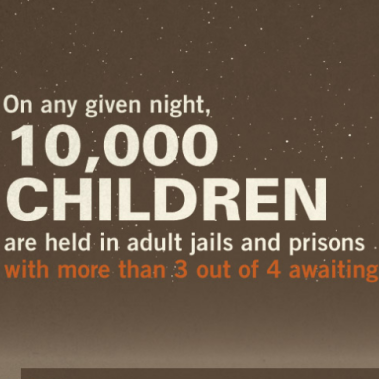In 2003, the Prison Rape Elimination Act (PREA) -- a federal legislative proposal that sought to curb incidents of sexual assault in both adult prisons and juvenile detention facilities -- was signed into law by President George W. Bush.
The newly formed National Prison Rape Elimination Commission (NPREC) was then tasked with establishing PREA standards; ultimately, nine years would pass before the United States Department of Justice (DOJ) approved the final standards set forth by the NPREC.

Campaign For Youth Justice
An infographic from the Campaign for Youth Justice regarding youth in the adult criminal justice system.
Regarding juvenile offenders, PREA Standard 115.14, also known as the “Youthful Inmate Standard,” is perhaps the most significant aspect of the federal legislation. Under PREA, adult facilities holding inmates under the age of 18 are required to implement policies that guarantee the segregation of minors from older prisoners -- a practice commonly referred to as “sight and sound separation.” Among other provisions, PREA prevents facilities from placing minors in cells with adult inmates, calls for constant supervision of juveniles in adult correctional facilities and limits the use of isolation as a penalty for young inmates.
However, the same standard is not applicable to juvenile detention centers -- even though most states allow for the housing of adults in such facilities. “The PREA standards do not provide for any sight and sound separation of residents in juvenile facilities either because of age or court of conviction,” the PREA Resource Center (PRC) states. “The Youthful Inmate standard requiring separation of those under age 18 from those over 18 is ‘setting specific,’ applicable only in prisons, jails, and lockups.”
The National Council on Crime and Delinquency (NCCD), that operates the PREA Resource Center (PRC) alongside the Bureau of Justice Assistance, referred the Juvenile Justice Information Exchange to the PRC for official comment.
With PREA finally becoming effective on Aug. 20, 2012, the first cycle of prison audits are scheduled to begin this month. To comply with PREA, jurisdictions must complete audits of at least a third of facilities before Aug 20, 2014. States that fail to comply by next year’s deadline are subject to a penalty that would see 5 percent of their DOJ grant funds revoked. And according to the PREA Resource Center, the brunt of punitive cutbacks may be centered on state juvenile justice departments, with both the Juvenile Accountability Block Grant program and the Juvenile Justice and Delinquency Prevention Act formula grant program cited as likely targets for de-funding.

Liz Ryan, founder, president and CEO of the Campaign for Youth Justice." credit="
Liz Ryan, founder, president and CEO of the Campaign for Youth Justice, said that while the regulatory processes behind PREA took longer than anticipated, she approves of the final standards that were authorized by the DOJ last year.
“Typically, regulations are issued within a year or two of a law passing,” she said. “This process took longer because it established a commission to really work with the field, to develop standards, and I think what they did was really good work.”
However, Ryan said she has concerns about how PREA may be implemented in some jurisdictions.
“I’m concerned about two sets of things,” she said. “One is that governors really don’t have this on their radar screens … the second set of concerns is the Justice Department’s implementation, oversight and enforcement of this law.”
While Ryan praised the Obama administration for pressing forward with PREA, she said that she does not believe the Bureau of Justice Assistance (BJA) should be in charge of handling enforcement.
“If you were to call over there right now and ask how many states were in compliance with PREA, they couldn’t tell you,” Ryan said. “They can’t tell you, because they don’t know themselves.”
A much “higher” agency, she said, should be tasked with PREA enforcement instead.
“The proactive work with governors and other officials in the states has been lacking,“ she said. “I think there should be a special unit created within the [U.S.] attorney general’s office that includes experts from the Civil Rights division and other juvenile criminal experts to ensure and actually proactively work with states on enforcement.”
The Youthful Inmate Standard, Ryan said, was an admirable attempt by the DOJ to ensure the protection of juveniles held in adult facilities, but she questions whether some facilities have enough staffers to supervise juveniles among adult general populations. And while Ryan believes that the Standard has good intentions, she believes the best way to prevent juveniles from being assaulted by adult inmates is to keep them out of adult facilities altogether.
“A lot of the correctional detention experts in the field believe the way to comply is to not have kids in those facilities at all,” she said. “If you were to ask most jailors, sheriffs and corrections officials in the adult system, they would say, ‘yeah, I don’t want kids in this facility.’”
Ryan praised Colorado for recently enacting legislation that bars juveniles from being held in pre-trial detention at adult facilities. Previously, states such as Ohio and Virginia had also passed bills barring the placement of juveniles in adult facilities while awaiting trial. Ultimately, Ryan said she hopes PREA enforcement, in particular the Youthful Inmate Standard, may encourage more states to pass legislation keeping juveniles out of jails and prisons housing adult inmates.
“A number of states have moved in this direction, not just removing them from adult facilities, but removing them from prosecution, automatically,” she said. “We think that is a positive step forward, and that it’s very consistent with what juvenile justice experts would say about this.”

Citizens for Juvenile Justice
Map showing the age of jurisdiction (age at which a youth can be tried as an adult) in all states. (Click image to see larger)
Naoka Carey, executive director of the Boston-based Citizens for Juvenile Justice, also said that PREA enforcement might serve as a catalyst for future state-level policy changes.
“Based on the research that we’ve done and the numbers that we have, we believe that there are probably a few hundred 17-year-olds who are held in adult facilities, over the course of the year in Massachusetts,” Carey said. Under current Massachusetts law, 17-year-olds charged with offenses are placed under the jurisdiction of criminal courts. Carey believes that PREA could provide a segue for the state to raise the age of criminality, and put young offenders under the jurisdiction of juvenile courts instead.
“We’re in the process, essentially, of changing our law,” Carey said. “And by changing our law, we will allow the 17-year-olds to come out of the adult system, and that would alleviate the Youthful Inmate issue.”
PREA, she said, adds a sense of urgency to a statewide movement to raise the age of criminality. “There are both the detention facilities, such as the court-holding facilities, and the police lock-ups that are affected, and there are the counties, the correctional facilities, that are affected,” Carey said. “So there’s a number of different players impacted by PREA.”
While Carey believes loss of federal funding may provide an incentive for some jurisdictions to comply with PREA, she also believes the potential for civil liabilities -- stemming from facilities that fail to meet minimum standards of care -- could goad some states into fully adhering to standards.
“Certainly, I think that here in Massachusetts, there’s also the moral incentive,” she added. “We don’t want people raped or assaulted or harmed in our facilities, and our people who run our facilities, I think, take that pretty seriously.”
Additional incentives for meeting PREA standards, Carey said, may further increase the likelihood that jurisdictions will meet compliance. These incentives, she said, do not necessarily have to be punitive.
“You could remove eligibility for future grants, which I think is still potentially a possibility,” she said. “The more things we do to both underscore the importance of these provisions and to create sort-of incentives and support to make sure they happen, the better.”

The map is not correct — at least as regards Oregon. I have not factchecked anywhere else, but Oregon’s Measure 11 requires that juveniles 15 and older are charged adults when charged with any among a long list of crimes. In addition youth as young as 13 have been charged and sentenced as adults.
Here’s what Multnomah county says:
https://web.multco.us/dcj-juvenile/measure-11
http://www.rkslawyers.com/Articles/Oregon-Teen-Gets-Life-in-Prison-for-Murder-Committed-at-Age-13.shtml